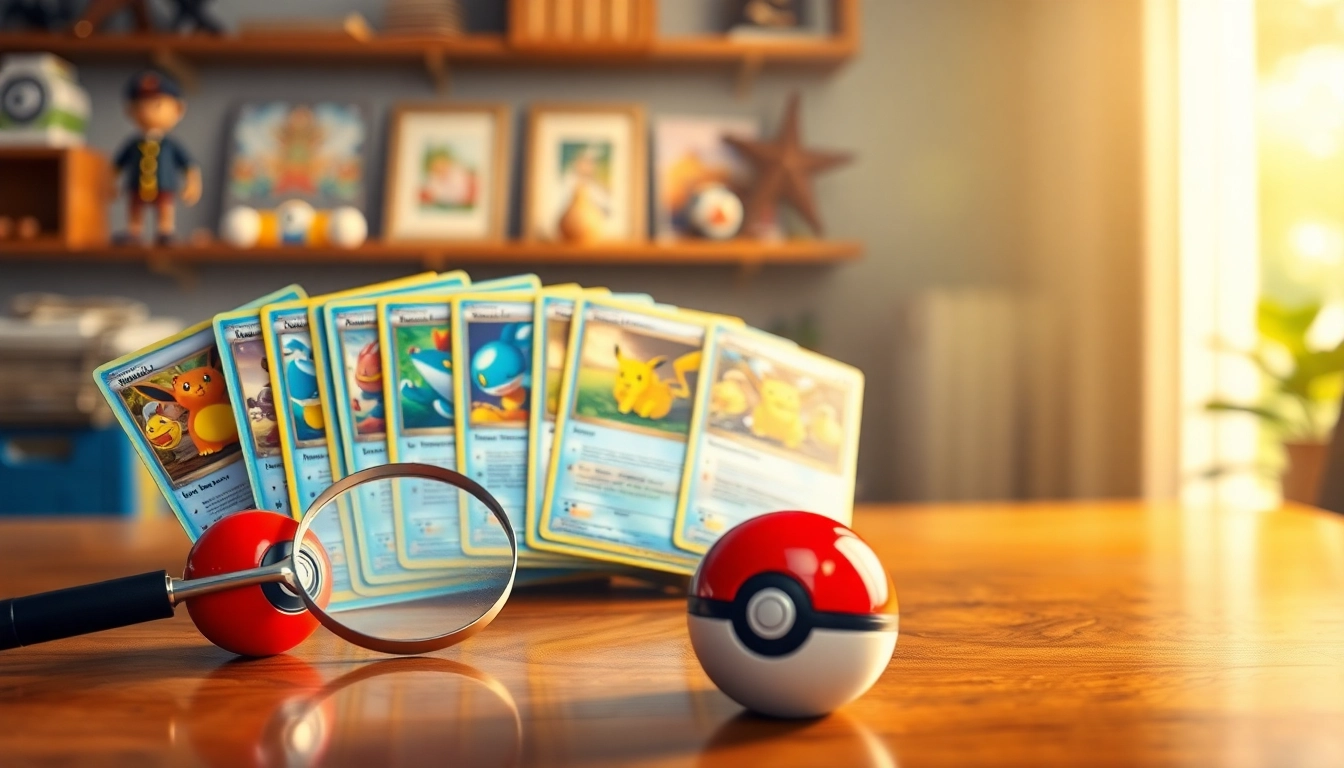Understanding Real Pokemon Cards
In the dynamic and colorful world of collectibles, Pokémon cards hold a pivotal place. As enthusiasts seek to expand their collections, the integrity and authenticity of these cards become paramount. Understanding what defines real pokemon cards not only enhances the enjoyment of collecting but also protects against potential scams and counterfeit items. This comprehensive guide dives deep into the specifics of what makes a card genuine, how to source them, and the essential factors to consider for collectors.
What Defines Real Pokemon Cards
Real Pokémon cards are officially licensed products designed by The Pokémon Company, featuring captivating designs and intricate details. But beyond just branding, several components distinguish genuine cards from their fake counterparts. Entry into the world of Pokémon cards begins with understanding these definitive characteristics.
Key Features and Characteristics
Real Pokémon cards exhibit unique features that ensure their authenticity. Here are some key characteristics to validate:
- Light Refraction: Real cards demonstrate a unique shimmering effect under light due to their ink and card stock quality.
- Print Quality: Authentic cards have sharp images and well-defined borders, unlike fakes that may appear blurry or pixelated.
- Card Weight and Thickness: Genuine Pokémon cards have a consistent weight and thickness. Weighing or measuring cards can sometimes reveal discrepancies.
- The Blue Core: A visual cue distinguishing real cards is the blue core layer visible when viewed from the edge. This feature is absent in many counterfeit products.
- Text Clarity: The text on authentic cards is crisp and correctly positioned without errors, a stark contrast to poorly made replicas.
Common Myths About Authenticity
As with any popular collectible, myths abound regarding the authenticity of Pokémon cards. Here are a few to debunk:
- Myth 1: All old cards are real. Fact: Condition doesn’t equate to authenticity; many fakes have existed since the series’ origin.
- Myth 2: All foil cards are valuable. Fact: Value is determined more by rarity and condition than the mere presence of a foil.
- Myth 3: Cards with a certain rarity symbol are guaranteed to be valuable. Fact: Value fluctuates with market trends; rarity doesn’t always guarantee high worth.
Where to Buy Real Pokemon Cards
The sourcing of real Pokémon cards can significantly affect a collector’s experience. It’s essential to buy from reliable retailers to ensure the authenticity of your cards. Below are some preferred channels for purchasing.
Top Retailers for Authentic Cards
The foremost retailers provide quality assurance, a vast selection, and the possibility of returning cards if they turn out to be fake. Some likable options include:
- Pokémon Center: The official site for Pokémon, offering a range of TCG cards and collectibles.
- TCG Player: An online marketplace that specializes in collectible cards, featuring verified sellers.
- GameStop: A trusted name in gaming, often stocking the latest Pokémon cards and expansion packs.
- Local Comic Shops: Oftentimes, local game and comic shops have genuinely authentic stock and provide the opportunity to inspect cards in person.
Online Marketplaces: Pros and Cons
While online marketplaces provide convenience, they also present unique challenges:
- Pros:
- Wider selection and competitive pricing.
- Accessibility to rare cards worldwide.
- Ease of transaction.
- Cons:
- Potential exposure to counterfeit cards.
- Shipping risks and delays.
- Limited recourse for fraud incidents.
Local Game Stores vs Big Retail Chains
Choosing between local game stores and larger retail chains depends on your goals as a collector. Local stores often offer a community atmosphere and knowledgeable staff, which can enhance your collecting experience. On the other hand, bigger chains might provide better pricing and promotions but lack personal service. Consider which reflects your collecting needs more closely.
Identifying Fake Pokemon Cards
Tackling counterfeit Pokémon cards is crucial for any collector. Knowing how to recognize fakes can save you money and frustration.
Spotting the Differences: Real vs Fake
The differences can be subtle, but they are there. Key indicators include:
- Color and Finish: Fake cards often exhibit colors that are either too dull or overly bright. Real cards have a vibrant but balanced color scheme.
- Card Setting: Cards should lay flat; warped or curled edges suggest a fake.
- Ruler Test: Real cards align uniformly; the thickness should be consistent across a series. Checking multiple cards from the same pack can be revealing.
Tools and Techniques for Verification
To verify the authenticity of cards, collectors can use various tools and techniques:
- Magnifying Glass: Checking for the holographic stamps and the print pattern can resolve many doubts.
- Light Test: Using a bright light source can reveal inconsistencies through the card layers.
- Comparative Analysis: Comparing suspected fake cards with verified real ones can provide direct evidence of authenticity.
Resources for Learning About Card Authenticity
Many websites and online forums are dedicated to Pokémon cards and their verification. Engaging with the community and researching credible sources will enhance your understanding. Consider visiting the official Pokémon trading card website which offers guidance as well as resources for authentication.
The Value of Real Pokemon Cards
The market for Pokémon cards is eternally fluctuating. Therefore, understanding the factors affecting value is essential for both new and experienced collectors.
Price Ranges for Different Types
The value of Pokémon cards varies widely based on several factors:
- Commons vs. Rares: Common cards may be worth a few cents, while holographic and rare cards can range from tens to hundreds of dollars.
- Grade Condition: Higher grades fetch higher prices. A Mint condition card can be worth exponentially more than one in Poor condition.
- Market Demand: Certain cards, especially those tied to popular Pokémon or recent expansions, may see spikes in value based on trends and community interests.
Factors Affecting the Value
Various influencing factors include:
- Scarcity: Limited releases massively affect card value. Cards like first-edition Pokémon cards from the base set have a storied price tag.
- Popularity: Rising interest in Pokémon due to accompanying media, games, or resurgence in the niche can inflate values.
- Historical Significance: Cards that were pivotal in competitive play or in the Pokémon saga often gain a collector’s fervor, driving prices higher.
Understanding Market Trends
Collectors should keep an eye on market trends through platforms like TCGPlayer and social media communities. Following auctions and sale data will offer insights into market sentiment and pricing structures influencing card values.
Building Your Collection of Real Pokemon Cards
Your Pokémon card collection can be a delightful and fulfilling hobby. Here are some tips for aspiring collectors to build their personal collections wisely.
Tips for New Collectors
Starting a Pokémon collection can feel overwhelming, but these pointers can ease the process:
- Set a Budget: Establishing a clear budget will help keep your collecting feasible.
- Focus on Goals: Decide whether you’re looking for specific cards, types, or just collecting for fun.
- Educate Yourself: Research specific cards, rarities, and sets to inform your purchasing decisions.
Maintaining and Preserving Card Condition
Maintaining the condition of your cards is crucial for preserving their value. Here are some preservation methods:
- Use Sleeves: Ensure cards are protected with card sleeves to guard against physical damage.
- Avoid Sunlight: Excessive sunlight can fade cards; store them in a cool, dry environment.
- Handle Carefully: Use clean hands when touching or displaying cards to avoid transfer of oils or dirt.
Joining the Pokemon Collecting Community
Being a member of the Pokémon collector’s community can enhance your experience. Engage in forums, attend local events or tournaments, and connect with other collectors to exchange knowledge, trade cards, and enjoy the camaraderie of like-minded individuals.



